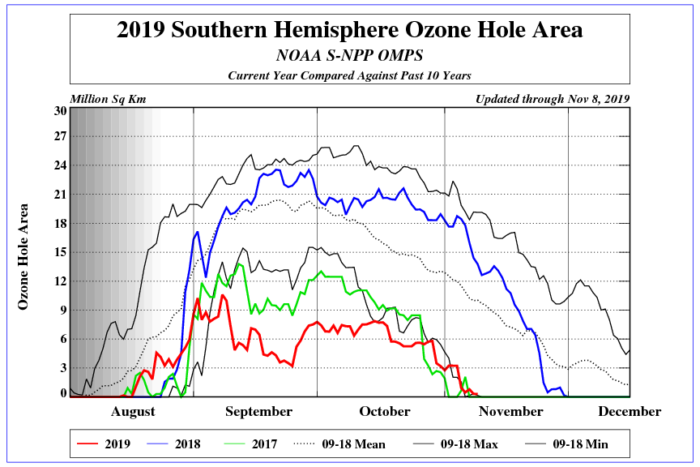CONTRASTING THIS SEASONS ARCTIC AND ANTARCTIC OZONE LEVELS
The Antarctic 2019 ozone “hole” was one of the smallest since the early 1980s. In contrast the ozone “depletion” over the Arctic this spring reached a record low in March. While such low levels are rare, they are not unprecedented. Similar low ozone levels occurred in the upper atmosphere, or stratosphere, in 1997 and 2011. The lowest March ozone value observed in the Arctic is usually around 240 Dobson units, but this year it reached 205 Dobson units. The 2019 Antarctic ozone hole reached a minimum ozone value of 167 Dobson units, higher than the lowest minimum ozone value of 92 Dobson units measured in 1994.
While, levels of chlorofluorocarbons and other man-made ozone-depleting substances have measurably decreased in the atmosphere and continue to do so and there are signs that the ozone layer is beginning to recover, year to year variations are driven by atmospheric conditions. The stratospheric temperature and the amount of sunlight reaching the south polar region control the depth and size of the Antarctic ozone hole, and in 2019 the stratosphere over Antarctica was warmer than the previous few years, so the ozone hole was smaller. The March Arctic ozone depletion was caused by a combination of factors that arose due to unusually weak upper atmospheric “wave” events that drive movements of air through the upper atmosphere. In a typical year, these waves travel upward from the mid-latitude lower atmosphere to disrupt the circumpolar winds that swirl around the Arctic. When they disrupt the polar winds, they do two things. First, they bring with them ozone from other parts of the stratosphere, replenishing the reservoir over the Arctic and second, the mixing warms the Arctic air. The warmer temperatures then make conditions unfavourable for the formation of polar stratospheric clouds. These clouds enable the release of chlorine for ozone-depleting reactions.

References
https://ozonewatch.gsfc.nasa.gov/
https://www.cpc.ncep.noaa.gov/products/stratosphere/polar/gif_files/ozone_hole_plot.png
https://www.nasa.gov/feature/goddard/2020/nasa-reports-arctic-stratospheric-ozone-depletion-hit-record-low-in-march
Solomon, S. et al. Emergence of healing in the Antarctic ozone layer. Science 353, 269–274 (2016).
WMO: Scientific Assessment of Ozone Depletion. Glob. Ozone Res. Monit. Proj.—Rep. No. 58, 588 (2018). 2018.
More information about Dobson spectrophotometers see April 2019 Newsletter item IN BRIEF EIGHTY YEARS OLD INSTRUMENT STILL MONITORING OZONE IN THE ANTARCTIC